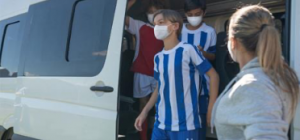
Adapted from insightful and frequently updated articles from the https://www.healthychildrens.org website:
The arrival of COVID-19 vaccines for ages 12 and up has been a game changer for many families. Being fully vaccinated can mean a safer return to fun and healthy activities like youth sports.
For children too young to get the vaccine yet, though, it is especially important to continue steps that reduce the risk of spreading the virus. Also keep in mind that many kids have been less active during the pandemic, raising their risk of certain injuries. Plus, any child or teen who has recently had COVID-19 needs to get a heart evaluation before returning to physical activity.
Read on for more ways to keep your child safe and healthy as they return to sports and other physical activity.
Before the sports season starts
| ☐ | Understand the safety rules and expectations for participation during COVID-19 and talk about them with your child. |
| ☐ | Make sure your child has their own face mask, hand sanitizer, towel, water bottle, and tissues labeled with their names. |
| ☐ | Call your pediatrician to make an appointment if your child needs a pre-participation physical exam. |
| ☐ | If your child hasn’t been active during COVID-19, start easing into exercise. For sports with a lot of running, for example, consider a beginner conditioning program (such as “Couch to 5K” or “None to Run” app) a couple of months before the season. This can help prevent injuries that sudden, intense activity can cause in growing children. It can also reduce the risk of heat-related illness in kids affected by obesity during the pandemic. |
Prior to practice or games
| ☐ | Keep your child home from practice or games if they’re feeling sick or have any symptoms of COVID-19, and get a test if the doctor recommends. |
| ☐ | Remind your child to wash hands before arriving, or use hand sanitizer if soap and water aren’t available. |
| ☐ | Bring labeled (with name) personal sports equipment, water bottle, towel, tissues, hand sanitizer, and face mask. |
| ☐ | For children not fully vaccinated, wear face masks when arriving or leaving the playing facility and off the playing field. Regardless of vaccination status, encourage your child to wear a mask in crowded indoor spaces such as locker rooms and shared transportation. |
| Returning to physical activity after COVID-19 infection
If your child has a positive COVID-19 test, notify their pediatrician. The doctor can advise how long they need to wait before returning to exercise or sports. This will be based on how severe their COVID-19 symptoms are, and whether they develop signs of multisystem inflammatory syndrome in children (MIS-C), myocarditis, or other post-COVID conditions:
|
During sports practice or games
| ☐ | If the sport is outdoors and your child is not fully vaccinated against COVID-19, they should wear face masks when on the sidelines, in the dugout, and during team chats. They should also wear them during group training and competitions when they aren’t able to stay at least 3 feet apart from others. |
| ☐ | Anyone not fully vaccinated should wear a face mask for all indoors sports training, competition and on the sidelines. However, masks should not be worn during:
• Water sports such as swimming and diving, since wet masks may be difficult to breathe through. • Gymnastics, cheer stunts and tumbling, and wrestling, to avoid masks getting caught on equipment or accidentally covering eyes. • Exceptions to mask-wearing might be a appropriate when the risk of heat-related illness is increased. |
| ☐ | Unless fully vaccinated, coaches, officials, spectators and volunteers should wear masks. In addition, anyone over age 2 who has had close contact with someone who has COVID-19, or has symptoms of the illness, should wear a mask. |
| ☐ | To help protect unvaccinated children, try to avoid:
• Huddles, high-fives, fist bumps, handshakes, etc. • Sharing food or drink with teammates. • Cheering, chanting, or singing when closer than 6-8 feet from others. • Spitting or blowing nose without a tissue. |
| ☐ | Store personal equipment 6-8 feet away from other teammates’ equipment. |
| ☐ | Minimize sharing sports equipment when possible. |
| ☐ | Sanitize hands before and after using shared equipment such as balls, bats and sticks. |
| ☐ | Tell a coach if you are not feeling well and leave practice or game with parent or caregiver. |
After sports practice or games
RememberTalk with your child’s pediatrician if you have any questions about youth sports participation safety, based on vaccination status, COVID-19 rates in your community and your child’s individual health. More Information
The information was adapted from material developed jointly by the American Academy of Pediatrics and the American Medical Society for Sports Medicine (AMSSM) and the National Athletic Trainers’ Association. |
Last Updated 8/2/2021
Source American Academy of Pediatrics, American Medical Society for Sports Medicine, and the National Athletic Trainers’ Association (Copyright © 2020)
Sky Pittson, MD, August 4, 2021


